
Cardamine hirsuta, commonly called hairy bittercress, is an annual or biennial species of plant in the family Brassicaceae, and is edible as a salad green. It is common in moist areas around the world.

Plumeria rubra is a deciduous plant species belonging to the genus Plumeria. Originally native to Mexico, Central America, Colombia and Venezuela, it has been widely cultivated in subtropical and tropical climates worldwide and is a popular garden and park plant, as well as being used in temples and cemeteries. It grows as a spreading tree to 7–8 m (23–26 ft) high and wide, and is flushed with fragrant flowers of shades of pink, white and yellow over the summer and autumn.

Myristica fragrans is an evergreen tree indigenous to the Moluccas of Indonesia. It is important as the main source of the spices nutmeg and mace. It is widely grown across the tropics including Guangdong and Yunnan in China, Taiwan, Indonesia, Malaysia, Grenada in the Caribbean, Kerala in India, Sri Lanka and South America.
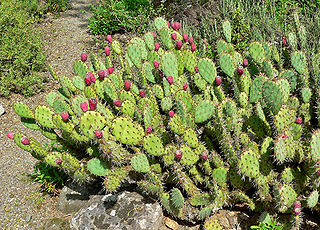
Opuntia, commonly called prickly pear, is a genus of flowering plants in the cactus family Cactaceae. Prickly pears are also known as tuna (fruit), sabra, nopal from the Nahuatl word nōpalli for the pads, or nostle, from the Nahuatl word nōchtli for the fruit; or paddle cactus. The genus is named for the Ancient Greek city of Opus, where, according to Theophrastus, an edible plant grew and could be propagated by rooting its leaves. The most common culinary species is the Indian fig opuntia.

Opuntia polyacantha is a common species of cactus known by the common names plains pricklypear, hairspine cactus, panhandle pricklypear, and starvation pricklypear. It is native to North America, where it is widespread in Western Canada, the Great Plains, the central and Western United States, and Chihuahua in northern Mexico.

Narcissus abscissus is a species of the genus Narcissus (Daffodils) in the family Amaryllidaceae. It is classified in Section Pseudonarcissus. It is native to France and Spain in the region of the Pyrenees.

Encephalartos friderici-guilielmi is a species of cycad that is native to Eastern Cape province and KwaZulu-Natal province of South Africa at elevations of 700 up to 1400 meters.
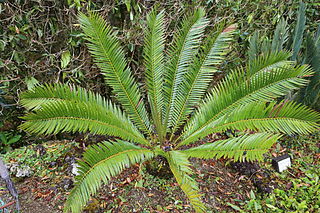
Encephalartos equatorialis is a species of cycad that is found on two granite hills on the eastern shore of Thurston Bay, Lake Victoria, Uganda at elevations up to 1000 meters.
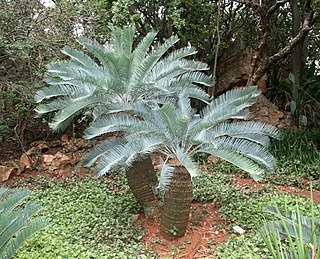
Encephalartos laevifolius is a species of cycad that is found in the KwaZulu-Natal, Mpumalanga and Limpopo provinces of South Africa, and at Piggs Peak in Eswatini. The species is facing extinction in the wild, but is widely cultivated.
Iris dolichosiphon is a plant species in the genus Iris, it is also in the subgenus Iris and in the section Pseudoregelia. It is a rhizomatous perennial, from China and Bhutan. It has long, thin dark green leaves, very short stem, and dark blue, purple, or violet flowers. That are mottled with white. It has thick white/orange beards. It has one subspecies, Iris dolichosiphon subsp. orientalis, from China, India and Burma. It has similar flowers. They are cultivated as ornamental plants in temperate regions
Iris goniocarpa is a plant species in the genus Iris, it is also in the subgenus of Iris and in the section Pseudoregelia. It is a rhizomatous perennial, from China, India, Burma and Bhutan. It has yellow green to dark green, long leaves, slender stem and, one flower between blue, lavender-blue, lilac, blue-violet or blue-purple. It is cultivated as an ornamental plant in temperate regions.
Iris hellenica is a plant species in the genus Iris and the subgenus Iris. It is a rhizomatous perennial, from Saitas Mountain, in the Peloponnese Region of Greece. It has grey-green, sickle-shaped leaves, a tall slender stem, 2–3 white, lavender-blue, lilac or purple flowers and orange/purple beards. It was thought once to be a hybrid species of Iris germanica which also grows in the same area, before being separated into 2 species. It has only recently been published and is rarely cultivated as an ornamental plant in temperate regions.
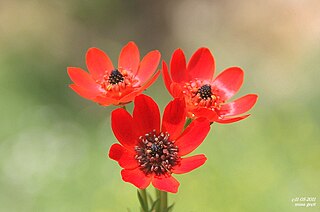
Adonis flammea is a species of plant belonging to the family Ranunculaceae.

Psittacanthus cucullaris is a species of mistletoe in the family Loranthaceae, and is native to Costa Rica, Bolivia, Colombia, Ecuador, French Guiana, Peru, Suriname, Venezuela and Brazil.
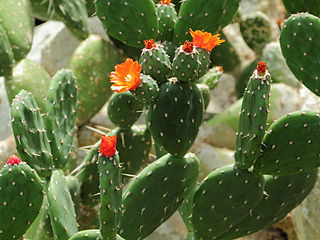
Opuntia quitensis is a species of columnar cactus found in Peru and Ecuador.
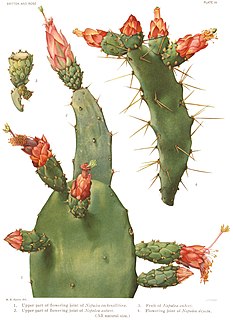
Opuntia auberi is a flower plant species belonging to the family Cactaceae. It is native to Central America in Cuba and the Antilles.
Rhizophora harrisonni is a species of plant in the family Rhizophoraceae. It can be found in Brazil, Cameroon, Colombia, Costa Rica, Ecuador, Guyana, French Guyana, Honduras, Nicaragua, Panama, Suriname, Trinidad, Tobago, and Venezuela.
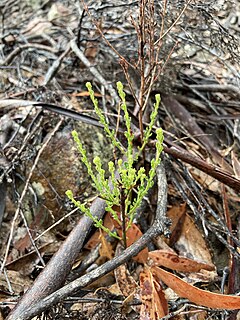
Gonocarpus teucrioides, or forest raspwort is a common flowering herb or subshrub in the Haloragaceae, or watermilfoil family. It is native to Queensland, New South Wales, Victoria and Tasmania and is widespread and abundant in the understorey of wet forests. The name raspwort refers to the rough, scabrous surface of many of the Gonocarpus species.
Pandanus aridus is a species of shrub or small tree in the family Pandanaceae. It is native and endemic to Madagascar, found in fragmented locations in the southern third of the country. Pandanus aridus H. St. John is the accepted name, with a synonym of Pandanus toliarensis Huynh.
Pandanus columnaris is a dioecious tropical plant in the screwpine genus. It is endemic to Madagascar. The specific epithet, "columnaris", refers to the columnar shape of the crown of the tree. Originally described by S. John as separate species, Pandanus columnaris is now considered a synonym for Pandanus pluriloculatus.














